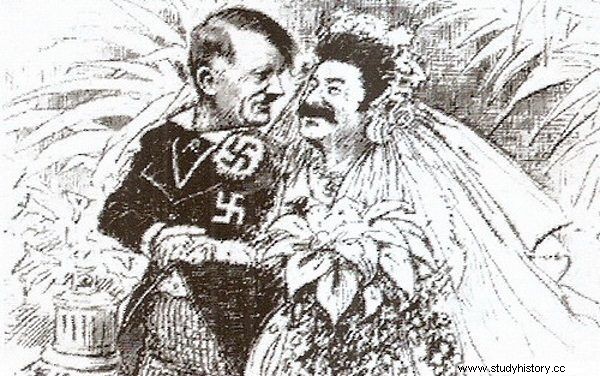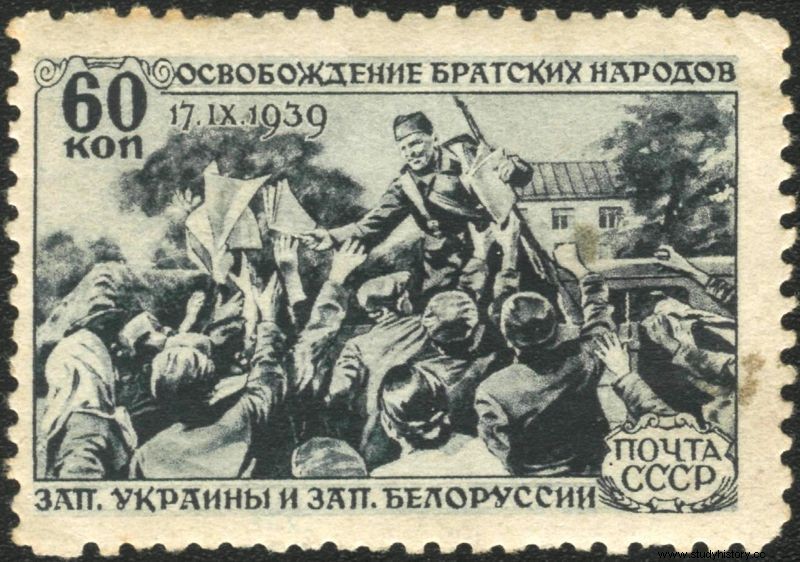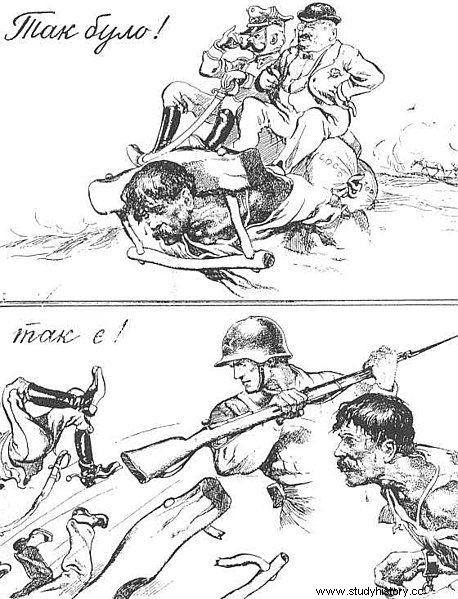On September 17, another act of the Polish tragedy began. The Red Army entered Poland. How did the USSR justify this decision? Can we talk about unjustified aggression? How did Soviet propaganda portray these events?
The naive, fearful of World War II, the Western world believed that Stalin had taken measures against Hitler. Undoubtedly, it was wishful thinking, as almost all of Europe knew the content of the Molotov-Ribbentrop Pact, also within the secret protocol, in which it was established that eastern Poland, Lithuania, Latvia and Estonia would be in the Soviet sphere of influence, and western Poland - in German. It was also declared that should there be slight changes in this respect, the USSR would receive appropriate territorial compensation. At the same time, both parties were forbidden from joining any other treaties directed against one of the parties.

Ribbentrop-Molotov Pact, caricature
However, the fear of war was so strong in Western Europe that we can conclude that countries such as England and France did not want to see the truth.
September 17, 1939
It is obvious that Polish diplomacy, for various reasons, was unable to ensure Poland's security. The alliances concluded with the then strongest states turned out to be insufficient in practice. But could it have been different? The growing threat from Germany prompted Great Britain to consider actions that should be taken to stop German expansion. It was even planned to convene a conference of the four powers that would deal with this problem. The Soviet Union would also take part in such a conference. However, Poland was against such an idea, opting for a bilateral alliance with Great Britain similar to the Polish-French alliance. It seemed that such a solution had been accepted by England, as Prime Minister Chamberlain stated in the British parliament that if the Polish government decided that its vital interests were at stake and decided to oppose the aggression by force, Great Britain would give Poland all the help .
Although the commander-in-chief Edward Rydz-Śmigły repeatedly wondered whether an alliance between Hitler and Stalin was possible, Poland was not aware of the agreement between these countries. On September 17, 1939, the Red Army entered Polish territory under the pretext of a liberation march. It was announced that the Belarusian and Ukrainian minorities, harassed on the territory of the Polish state, were being liberated. The USSR thus broke the non-aggression pact that these countries concluded in 1932.
Wacław Grzybowski - the Polish ambassador to Moscow was summoned to the Kremlin, where he was told that the Polish state had ceased to exist and therefore the government of the USSR decided to take care of the people of Western Ukraine and Belarus. This was to justify the fact that the USSR was breaking the treaties previously concluded. Molotov, the commissar of foreign affairs of the USSR, informed at the same time that the Red Army had been ordered to cross the border with Poland. The ambassador did not accept this note, which, however, was only symbolic.
The London Times described the events of September 17, 1939 with stabbing Poland with a knife in the back. England and France filed protest statements in Moscow, but there were also voices that the aggression was in fact anti-German. The Red Army stabbed the back of the fighting Poland. The situation was additionally worsened by the order of the Supreme Commander Marshal Edward Rydz-Śmigły ordering to avoid fighting the Russians unless the soldiers are attacked by the Red Army and withdraw to Romania.
“The Soviets have stepped in. I am ordering a general withdrawal to Romania and Hungary by the shortest routes. Do not fight the Bolsheviks, except in the event of an attack on their part or an attempt to disarm the troops. The task of Warsaw and the cities that were to defend themselves against the Germans - no changes. Cities approached by the Bolsheviks should negotiate with them about the exit of the garrisons to Hungary or Romania. "
The Polish government decided to leave the territory of the country to continue the fight in exile. The aggression of the USSR complemented the fate of Poland.
September 17, 1939. Aggression in the Soviet propaganda
In the Soviet propaganda, Poland presented itself as a fascist country. Even in the 30s of the twentieth century in the Polish lands, and more specifically in the north-eastern borderlands, circulated the leaflet "Do not give Ukrainian grain to Polish landowners" . They were echoes of the Polish-Bolshevik war, but it showed well the level of manipulation. Other slogans of this period include "Down with the fascist, Polish occupation. Western Belarus demands separation from Poland ” .

Propaganda postage stamp - liberation of Western Belarus and Ukraine by the Red Army
Soviet propaganda cinema showed the extreme plight of Belarusians and Ukrainians under the Polish yoke. In films such as "Wind from the East" or "Dream", Poland was presented as a country of criminal lawlessness of policemen and gendarmes . It showed crimes against the civilian population and abuses of state power.

Propaganda poster showing Soviet aggression as an act of liberating minorities from the yoke
After September 17, 1939, Soviet propaganda said that the Red Army was moving like a storm. It was not true. Half of the planned forces were collected, and the army also had a lot of problems with supplies. The Poles offered stronger resistance than expected. On the leaflets signed by the leader of the Ukrainian front, S. Timoshenko, scattered on the territory of Poland, we read:
Soldiers! What is left for you? What and who are you fighting for? What are you risking your life for? Your resistance is ineffective. Officers rush you to certain slaughter. They hate you and your families. It was they who shot your delegates whom you sent with a proposal to surrender. Don't believe your officers. Officers and generals are your enemies, they want you dead. (...) Remember that only the Red Army will free the Polish nation from the unfortunate war and you will be able to start a peaceful life.

Propaganda poster showing the alleged abuses of Poles
Read also:10 most important battles of the defense war in September 1939
More than half of the territory of Poland was under Soviet occupation and the western part under German occupation. At the end of October 1939, Molotov described the cooperation in the war against Poland by saying the characteristic words:
A short attack, first by the German troops, and then by the Red Army, was enough for nothing left of this crude creation of the Versailles Treaty to survive the oppression of non-Polish nationalities.
In the plans of both occupiers, this was to be the final end of the Polish state. However, fate ordered otherwise…
Bibliography:
- Polish Radio - Interview with prof. Wysocki Our eastern neighbors still pretend that in 1939 they helped Poles,
- "Backstab" documentary,
- J. Łojek, Aggression September 17, 1939 , PAX Publishing Institute, Warsaw 1990,
- N. Davies, God's Playground, Znak, Krakow 2006
